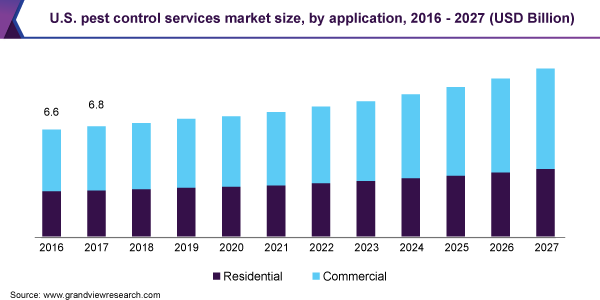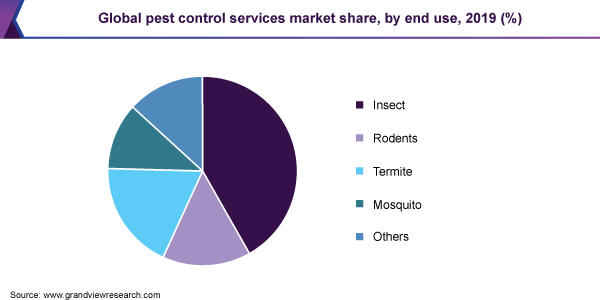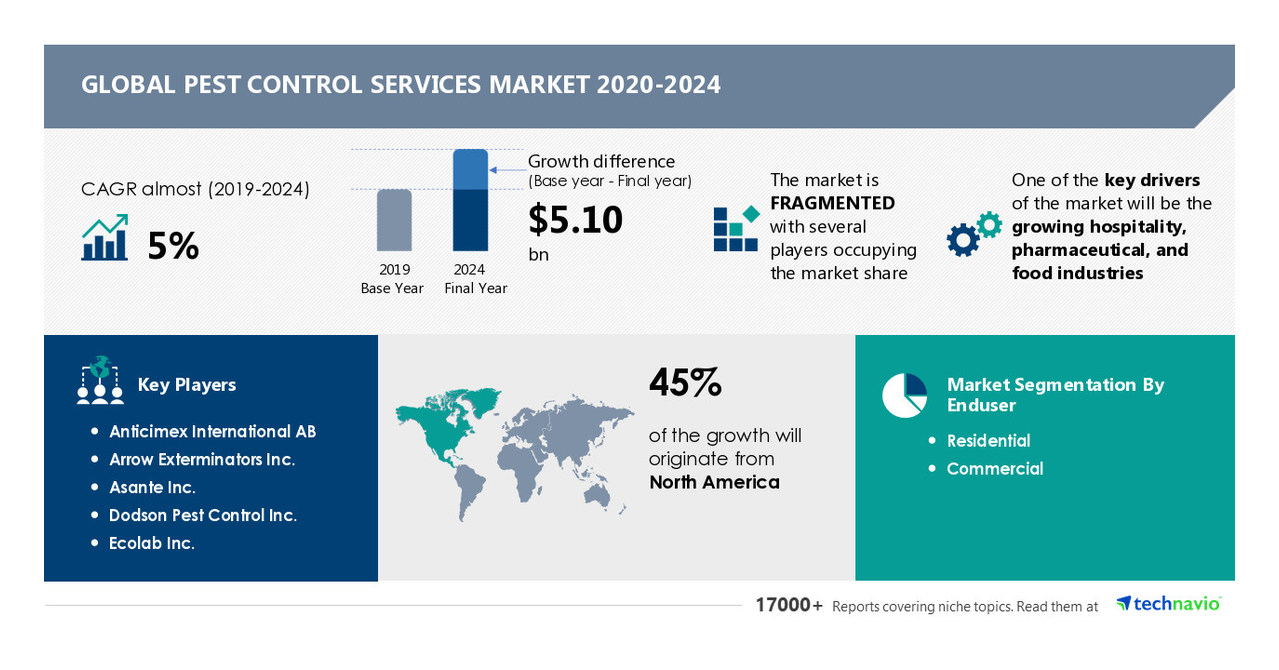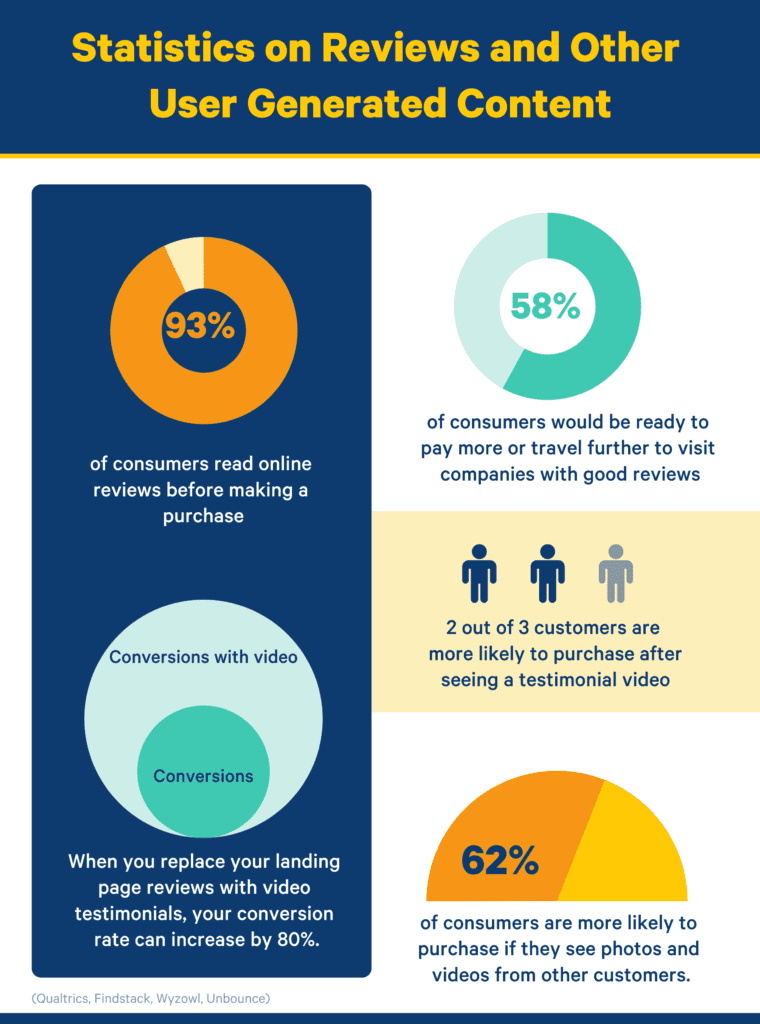Starting a business in the pest control industry is a great choice this year. With an evaluation of $24.9 billion for 2023 and a compound annual growth rate of 5.7% between 2023 and 2028, business is booming. In fact, at this rate, it could reach an evaluation of $32.8 billion in 2028.

Providing pest control services can be an extremely lucrative business once established. Not only is there huge market potential, but the barriers to entry are relatively low in this industry. With some know-how, the right equipment, and a solid business plan, virtually anyone can start a successful pest control business.
In this guide, we’ll talk about how to start pest control business. Topics include market research, competitive analysis, registering an EIN, obtaining business insurance, and forming an LLC. Here’s everything you need to get started in pest control.
1. Conduct Pest Control Market Research
Market research is essential to starting a new pest control business. It offers insight into the target market, local saturation amongst competitors, trends in products and services, and more details pest control business owners should have access to.

Some of the details you’ll learn through market research include:
- While already substantial, market growth is projected due to numerous factors.
- Urbanization is occurring rapidly globally, and densely populated cities provide more breeding grounds for pests.
- Supply chain issues allowing inventory storages to grow, warmer winters from climate change letting pests spread farther geographically, and cautious post-pandemic sanitation creating higher standards are all growth drivers.
- With over 20,000 providers already established nationally, the market may seem saturated.
- However, the fragmentation of the industry provides business opportunities.
- The 10 largest pest control companies hold under 40% market share, meaning the majority are small operators.
- The low overhead also reduces barriers to entry, enabling entrepreneurs to compete.
- Most providers are locally focused, specializing in their city or region.
- Targeting an underserved nearby community by promoting quality services and local knowledge can be a recipe for quick success.
- Partnerships with construction companies and real estate agencies also drive reciprocal referrals year-round.
While already substantial, the U.S. pest control industry is poised for significant growth this decade through urbanization, climate impacts, post-pandemic caution, and the overall necessity of service. With a highly fragmented market dominated by small providers, the opportunities are plentiful for an aspiring pest control business owner.
2. Analyze the Competition
With over 22,451 pest control establishments nationally, competition analysis is crucial when entering this fragmented industry. An estimated 70% of providers are one to five-person operations, so targeting small competitors is key. To be a successful business, you need to see what other successful companies do.

The first step should be identifying existing companies based locally, through these methods:
- Search online directories and drive around town and nearby cities to make a list.
- Get referrals from real estate agencies and hardware stores on frequent recommendations.
- Mystery shop your competition by posing as a potential customer to learn their pricing structure, types of pests covered, service guarantees, and professionalism first-hand.
- Take note of any lacking components you could improve on.
- Pay attention to their vehicles also – poor quality vehicles signal potential weakness.
- Research online reviews for these competitors so you understand customer pain points and preferences.
- Use sites like Yelp and Google to see what past clients focus their comments on regarding needs being met.
- Competitors with no or few online reviews should be easy to outrank quickly with a well-optimized Google Business profile and social media presence driving customer feedback.
- Another easy way to assess the digital competitiveness of pest control rivals is to search for their business name and city on Google.
- Analyze what shows up on page one – if it’s only directories and ads with no online properties for that company, claiming local organic search visibility should be attainable.
- Use Google Analytics to monitor keyword ranks monthly.
By combining mystery shopping, review analysis, organic search domination checks, and physically counting local pest control competitors, new market entrants can expose major gaps to leverage in their custom offerings and marketing. Then test these assumptions directly with customers.
3. Costs to Start a Pest Control Business
Any pest control business starting up will encounter costs. There are a variety of one-time start-up costs and ongoing expenses to consider before being operational. Proper budgeting for these expenses is crucial for funding this initial overhead needed to open doors.
Start-up Costs
- The first major cost is vehicles. Expect $35,000+ for a new customized van or truck equipped with pesticide storage and spraying equipment. Buying used or renting equipment can save substantially or allow purchasing multiple vehicles.
- Equipment such as spray rigs, pumps, pesticide applicators, and PPE gear will be around $8,500+ depending on inventory needs. Ongoing chemical supply restocking should be $600 monthly once established.
- Insurance is critical covering $1 million+ general liability, auto/truck, and workers comp in case of accidents. Annual premiums often fall between $2,000-$5,000. Shop policies and maintain safety protocols to decrease this major expense.
- State business licensing, permits, and training averages under $1,000 in most regions but ensures full legal compliance from day one. Account for more in certain localities.
- Brandings such as logo design, uniform embroidery, truck wrap graphics, business cards, and flyers will likely cost around $3,000 initially. Quality branding conveys professionalism and safety in this industry.
- Plan for $10,000 in initial digital marketing and optimization for expertly configured websites, Google Business profiles, citations, and advertising execution. Maintaining $5,000 annually covers refinements.
- Office space leasing averages $20/square foot in most regions, with 500 feet adequate for small teams. This equals $10,000 yearly rent or $250,000+ for purchasing a commercial condo. Expect additional build-out costs if constructing office space.
- While starting, customer service staffing is recommended over hiring additional field techs to ensure quality control and relationship building. Start with one dedicated office employee at a $45,000 salary.
In total, around $70,000 in starting capital covers the core infrastructure costs of launching operations. This enables managing cash flow properly before increasing monthly recurring revenue and scaling the business.
Ongoing Costs
- On the monthly budget side after launching, expect another $15,000+ in ongoing overhead costs within the first year. Expand crews and marketing once establishing operations flow and sales pipeline conversion rates.
- Major fixed costs include $5,000+ in marketing management fees (including ad spends) and $2,500 for software/tools covering customer records, scheduling, invoicing, email marketing, accounting, 3rd party citations, and more.
- Assume a $1,500 monthly average for vehicle/equipment maintenance buffers, gas, surprise repairs, and associated labor. Also include uniform cleaning, office supplies, and printing brochures here.
- The $1 million insurance policy averages $375 monthly in premiums but expands as employee count and fleet size grows. Maintain safety standards to prevent increases.
- Build out net 60 contracts to ease cash flow, expecting around $7,500 monthly payroll for office admin and a two-person field crew including taxes and reasonable salaries.
While start-up budgets over $100k help compress time to profitability through more robust initial spending, opening intelligently on $70k enables scaling smartly. Adding crews and lead gen spending once revenue sustains prevents early overextension.
4. Form a Legal Business Entity
When starting a pest control company, the legal structure chosen impacts taxes, liability, and expansion options. Evaluating these entities – sole proprietorship, partnership, LLC, and corporation – enables selecting what’s best long-term.
Sole Proprietorship
A sole proprietorship is the easiest and cheapest, requiring only a business license. However, the owner carries full liability for debts and lawsuits, putting personal assets at extreme risk by handling pesticides and working inside client properties. These cons typically make sole proprietorships inadvisable despite the ease of setup.
Partnership
Forming a partnership spreads risk across two owners and enables raising more starting capital. But all owners share personal liability, meaning claims or judgments against one financially impact the other’s assets too according to state laws. The ability to dissolve partnerships easily also jeopardizes long-term business stability. So while helpful initially, exposure downsides remain.
Limited Liability Company (LLC)
Forming a limited liability company (LLC) creates the best of all worlds for pest control outfits – personal asset protection combined with pass-through taxation. LLCs limit legal and debt exposure to the business itself if correctly structured, crucial in this industry. Operation flexibility, good reinvestment incentives via taxation, and easy addition of partners or investors provide scalability.
Corporation
The corporation status is an unnecessary complexity for pest control outfits despite maximum liability protection. Double taxation creates excess costs without significant benefits toward ownership structuring or raising capital down the line. Stick with the operational flexibility of an LLC instead of these burdens requiring corporate formalities.
5. Register Your Business For Taxes
An Employer Identification Number (EIN) serves as a business’s IRS tax ID number for tax filing and reporting purposes. Sole proprietors typically use SSNs, but LLCs, corporations, and partnerships must obtain an EIN.
This ID number enables opening business bank accounts, applying for licenses/permits, hiring employees later, and legally operating. The IRS EIN application is free and available online.
To apply, first, determine your business entity type if undecided – LLC is best for pest control outfits. Have owner names, addresses, and SSNs handy.
Next, navigate to the IRS EIN Assistant and select Apply Online Now. Answer whether you have any employees (no when starting).
Provide the legal name and “doing business as” name if applicable. List the main business address and principal business activity (exterminating services).
Double-check all entries to ensure no typos before submitting. Once validated, your EIN should display immediately to print/save for records.
Additionally, visit your state revenue department to register for sales tax reporting needs. This facilitates proper tax collection/remittances as the business grows.
Spending a few quick minutes obtaining an EIN and sales tax ID prevents major legal headaches and ensures smooth ongoing tax compliance as a pest control entrepreneur. Don’t risk hefty IRS penalties by delaying this critical business formation step.
6. Setup Your Accounting
Proper financial tracking is crucial for pest control companies to maintain profitability and stay IRS audit-proof. Leveraging tools like software and accountants prevent major headaches.
Accounting Software
QuickBooks is the go-to small business accounting platform. Connecting bank/credit card accounts automatically imports transaction data, removing the manual entry. Features like invoice creation, payroll management, tax preparations, and real-time reporting provide tremendous efficiency. Expect around $30/month.
Hire an Accountant
While software handles backend recording, partnering with an accountant ensures taxes, payroll, financial statements, and advisory services stay optimized as you scale. Expect around $200 monthly for basics like bank reconciliations, journal entries, state registrations, and sales tax filings. Utilize an accountant at least for annual filings to maximize write-offs, costs range from $500-$1,500 depending on company complexity.
Open a Business Bank Account
Keeping pest control business finances 100% separate from personal transactions is also vital. Doing so avoids commingling issues during IRS audits that assume all shared account activity is taxable business income. Open a named commercial bank account solely for company use before accepting any client payments.
Apply for a Business Credit Card
Obtain a dedicated business credit card in the company name only. Provide the legal entity registration, EIN, and estimated annual revenues when applying to establish a sizable credit line. Cards like Chase Ink Business offer bonus rewards categories like gas and sign-on bonuses.
7. Obtain Licenses and Permits
Running afoul of state and federal licensing mandates leaves pest control outfits exposed legally and financially. Find federal license information through the U.S. Small Business Administration. The SBA also offers a local search tool for state and city requirements.
Since pesticide application sits at the core of services, obtaining an Operator Identification Number is pivotal. States regulate chemical usage heavily – this ID number gets listed on product labels after passing certification exams per EPA mandates. Renewing routinely ensures staying current on evolving regs.
Research state-level business license needs beyond municipal requirements. For example in Texas, the Structural Pest Control Service business license covers key aspects like financial responsibility and staff oversight per the Department of Agriculture. Many counties and cities add permits too.
Validate insurance minimums since services like fumigations and commercial clients may require $1 million+ general liability coverage to protect all parties. Adjust as the customer base expands over time.
For any company vehicles, stay vigilant on registration renewal dates to prevent lapses. Commercial auto insurance also stands separate from personal policies with distinct stipulations like higher mandatory limits since crew members transport chemicals routinely in service of the business across properties. Let gaps lapse and expect policy claim denials later.
Check locally to confirm if additional public health permits apply for the pesticides themselves beyond EPA needs. Some urban areas add their own containment and reporting criteria for environmental/public transparency.
While administrative, no business license ensures smooth service delivery like that of payment processing. Secure a merchant services account through a bank upon forming the business entity to accept recurring client payments reliably via cards, bank transfers, and mobile apps.
8. Get Business Insurance
Protecting a pest control business with comprehensive insurance is non-negotiable given the high-risk services performed across client properties. Going without policies leaves the company and personal assets vulnerable. Just a few uncovered accidents could bankrupt the operation and owners.
For example, a tech accidentally knocking over an antique vase valued at $15k while treating a luxury home for termites could financially devastate the business if no insurance exists. Even basic slips causing injury put the company on the hook for medical bills and legal judgments destroying hard work overnight.
Additionally, a failed fumigation treatment allowing lingering gas leakage not caught until new homeowners move in months later causes hospital bills for the family, lawsuit judgments, settlement fees, and reputation loss impossible to bounce back from if uninsured.
Even company vehicles being damaged by other drivers, employees in at-fault accidents, or theft/vandalism of expensive spray equipment can tank operations without policies narrowly covering these frequent exposures.
Protect against catastrophic loss by getting insured in three key steps:
- Research state minimums and find a broker specializing in pest control insurance needs regarding general liability, commercial auto, professional coverage, etc.
- Prepare current financials, employee info, vehicle VINs, license details, and a comprehensive customer property list to complete applications fully.
- Maintain active policies across all locations, workers, and equipment refreshed annually as the business evolves, not forgetting excess liability coverage as assets grow.
Don’t undermine the sweat equity invested by overlooking insurance. The risks demand proper protection in place from the beginning.
9. Create an Office Space
Securing office space provides pest control owners key infrastructure for sales meetings, employee oversight, and centralized equipment/paperwork storage to enable company growth. The optimal location balances functionality, professionalism, and affordability.
Home Office
Utilizing an extra bedroom as a home office makes sense initially keeping overheads low. Meet clients by appointment while establishing operations. Just ensure properly zoned for business use.
Retail Office
For client-facing credibility as the customer base expands, securing retail space like a small storefront sells trust, assuming foot traffic exists from nearby homes or businesses. Signage drives brand awareness too. However, long leases and utility costs often eclipse early revenue.
Coworking Office
Coworking spaces like WeWork provide professional communal offices rentable short or long-term in most cities. Custom build-outs, conference room access, front desk staff, and flexible lease periods reduce risk. Expect to budget $300+ monthly for dedicated office space depending on market rates.
Commercial Office
Eventually leasing a dedicated commercial unit removes reliance on shared building resources allowing customized security system installs, controlled access, ample parking, and privacy to grow the team over time. Expect $20+/square foot in lease payments, however, so validate consistent sales pipeline revenue first. Ownership has tax advantages long run but carries renovation costs and mortgage obligations.
10. Source Your Equipment
Launching a pest control operation hinges on securing key specialized equipment like spray rigs, protective gear, tanks, and chemicals in addition to transportation – either new or used depending on budget. Sourcing smartly curbs costs while still obtaining what enables services.
Buy New
Buying new directly from manufacturers enables fully customized equipment specs like stainless steel pumps; electric-powered, low-volume application sprayers, and ergonomic carrying capacity catered to technique. However at $7,000+ per rig and long lead times, tap savings avenues first.
Buy Used
Used marketplaces like Facebook Marketplace and Craigslist provide local pickup of quality gear at 50%+ discounts from retiring operators. Listings like “Pest Control Business Equipment Sale” are common. Bring knowledgeable technicians along to inspect items fully before purchasing.
Rent
Renting equipment short-term boosts capabilities like adding larger spray units for one-off fumigations without a huge investment. Rental organizations facilitate access based on the location/dates required. Note transportation/cleaning fees, however.
Lease
Leasing through specialty financing firms offers another way to keep large rig purchases off the books when funds are limited while building a business credit history. Expect 20-30% APR however across 3-5 year terms. Consider securing working capital lines from mainstream banks first before leveraging to upgrade.
11. Establish Your Brand Assets
Crafting a distinctive brand identity makes grabbing market share easier by building instant recognition and trust in an extremely competitive niche. Memorable logos, professional contacts, and online properties telegraph quality and service capabilities at every touchpoint.
Get a Business Phone Number
Start by establishing a branded business phone and messaging with RingCentral. Choose an easy-to-recall custom number like your city area code plus “PEST” to stick in customers’ minds.
Design a Logo
Next create a bold logo and visual identity system through affordable sites like Looka to convey professionalism consistently across trucks, uniforms, websites, signs, and ads. Consider memorable mascots or icons to stand out since most competitors rely on generic house/bug graphics.
Print Business Cards
Business cards also make professional first impressions so clients recall the correct details to share referrals later. Carry stacks sourced via Vistaprint to leave after in-home consultations and pass out at local networking events.
Buy a Domain Name
Owning the branded domain protects brand integrity online long-term. Use .com extensions via registrars like Namecheap for trust and security continuing website hosting switches.
Design a Website
Create sites yourself through user-friendly platforms like Wix to maintain full control over pages, blog content, and SEO elements driving organic traffic. Or outsource initially to conversion rate experts found on sites like Fiverr to launch faster.
12. Join Associations and Groups
Connecting locally helps pest control entrepreneurs expedite success through collective wisdom on crucial aspects from permit navigation to marketing breakthroughs. Don’t attempt tackling all roadblocks alone.
Local Associations
Search sites like PestWorld and EPA for regional chapters of groups like the National Pest Management Association to leverage existing frameworks to exchange solutions at monthly meetups. Example groups like the Georgia Pest Control Association connect statewide operators formally.
Local Meetups
Local Meetup search also uncovers more informal gatherings interested in tackling shared pest control obstacles from SEO to lead gen through networking alongside complementary home service pros frequently tackling adjacent topics.
Facebook Groups
Industry-specific Facebook Groups like Pest Control Professionals, provide crowdsourced answers to in-the-field equipment issues, tips on the latest tablets and apps increasing inspection and booking efficiency, or guidance navigating insurance claim fires. Alongside hyperlocal groups focused on the nearest urban business cluster.
13. How to Market a Pest Control Business
Implementing an ongoing pest control marketing strategy is pivotal for pest control outfits to continually fill sales pipelines as competitors vie for the same customers. An integrated digital and traditional approach targets homeowners when they need services most.

Personal Networking
First focus on delighting every customer by overdelivering so they confidently refer friends/family while sharing reviews showcasing reliability and quality care. For example, offer frequent home re-inspections as pests evolve seasonally. Providing such attentive protection earns loyalty and referrals.
Digital Marketing
Digital channels then enable scalable lead generation tapping into buyer searching/sharing behaviors:
- Google Ads geo-target nearby high-intent searchers querying issues exactly matching services. Continually test new keyword/landing page combinations to lower cost per lead.
- Facebook Ads allow ultra-customized demographic targeting, retargeting recent site visitors, and lookalike expansion finding more similar prospects.
- Start a YouTube channel documenting pest removal first-hand for traffic and trust signals. Embed site links in video descriptions.
- Write SEO-optimized blog content around common local concerns like mosquito risks or detection signs hyperlinking to booking pages.
Traditional Marketing
Traditional options also maintain awareness:
- Print full-color flyers and mailers spotlighting seasonal offerings to distribute in afflicted neighborhoods and apartment buildings.
- Sponsor booths at home shows to meet hundreds of prospects and following up promptly increases quote conversions.
- Arrange public library or community center educational seminars on prevention methods and when to enlist pros. Capture attendee info.
- Radio ads scheduled appropriately around outdoor activity seasons ensure hitting listeners exactly when vulnerability strikes, prompting calls.
The most effective marketing appropriately balances new customer acquisition goals and current client nurturing through an always-on multi-channel approach optimized continually by response rates. Budget testing determines the optimal media mix over time per market.
14. Focus on the Customer
Providing best-in-class customer service goes beyond completing contracted extermination treatment effectively at each visit. The most successful pest control outfits transform themselves into trusted family advisors. Some ways for pest control businesses to connect with customers include:
- This level of consultative partnership earns referrals and repeat sales automatically without constant marketing spend chasing new one-off clients.
- Take time explaining how to pest-proof vulnerable home entry points during visits instead of rushing off to the next appointment. Follow up periodically to check for reoccurrences.
- Share seasonality insights proactively so customers know what to expect and when to book follow-up treatments even without new sightings if changing weather patterns likely reopen risk.
- Email helpful pest prevention tip sheets frequently.
- Overlay a layer of protective partnership beyond merely applying chemicals on-site.
This customer service-focused approach cements trust and retention ultimately cultivating customers so satisfied with the elevated partnership that they voluntarily suggest friends and neighbors use the company upon discovering any risks near them as well. Converting referrals then becomes much easier after such endorsements.
